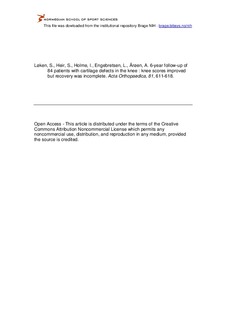6-year follow-up of 84 patients with cartilage defects in the knee : knee scores improved but recovery was incomplete
Journal article, Peer reviewed
Permanent lenke
http://hdl.handle.net/11250/170525Utgivelsesdato
2010-10Metadata
Vis full innførselSamlinger
- Artikler / Articles [2119]
Originalversjon
Acta Orthopaedica. 2010, 81(5), 611-618Sammendrag
Background and purpose: The natural history of focal cartilage
injury is largely unknown. In this study we investigated 6-year
outcomes in patients with arthroscopically verified, focal, fullthickness
cartilage injuries of the knee.
Methods: In a previous report (baseline study) of 993 knee
arthroscopies, 98 patients were less than 50 years old at baseline
and showed grade 3–4 focal cartilage injury, as assessed with the
International Cartilage Repair Society (ICRS) scale. In the present
study, 84 of the 98 patients completed follow-ups at median
6.1 (5.3–7.8) years after baseline assessments. At baseline, the
patients had undergone different types of cartilage repair (n = 34)
or had no treatment or only debridement (n = 64) for their cartilage
injury. The follow-up included evaluations with the ICRS
knee evaluation form, the Lysholm score, and other knee evaluation
tests. 68 patients underwent radiographic assessments with
weight bearing. Results: Improvements compared to baseline were noted in
the average ICRS functional score, visual analog scale (VAS) pain
score, and the patients’ rating of the function in the affected knee
compared to the contra-lateral knee. However, the average ICRS
activity level had decreased from baseline. The average Lysholm
score was 76 (SD 21). 19 patients had Kellgren-Lawrence grades
2–3 in the affected knee and 6 patients had grades 2–3 in the contralateral
knee. There was a statistically significant difference
between affected and contralateral knees.
Interpretation: Patients with arthroscopically diagnosed ICRS
grade 3–4 cartilage injuries in the knee may show improvement
in knee function over the following 5–8 years, with or without
cartilage repair. However, knee function remains substantially
affected. Further studies are needed to determine whether cartilage
surgery can yield better functional outcomes than non-surgical
or less invasive surgical treatments.
Beskrivelse
Open Access - This article is distributed under the terms of the Creative Commons Attribution Noncommercial License which permits any noncommercial use, distribution, and reproduction in any medium, provided the source is credited.
